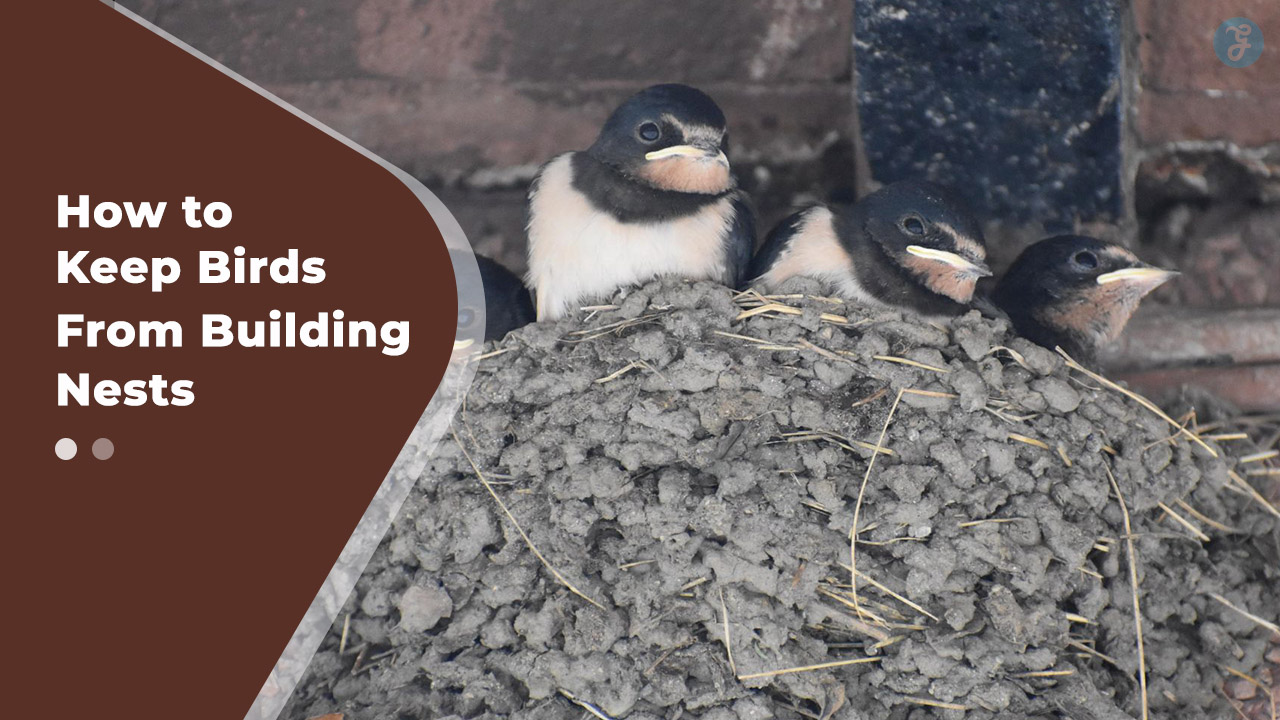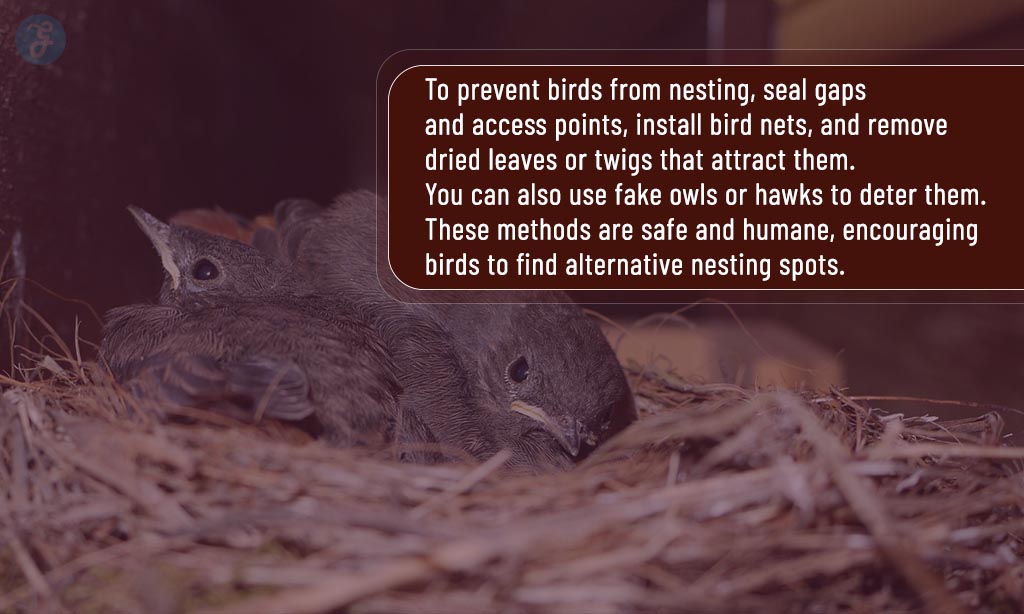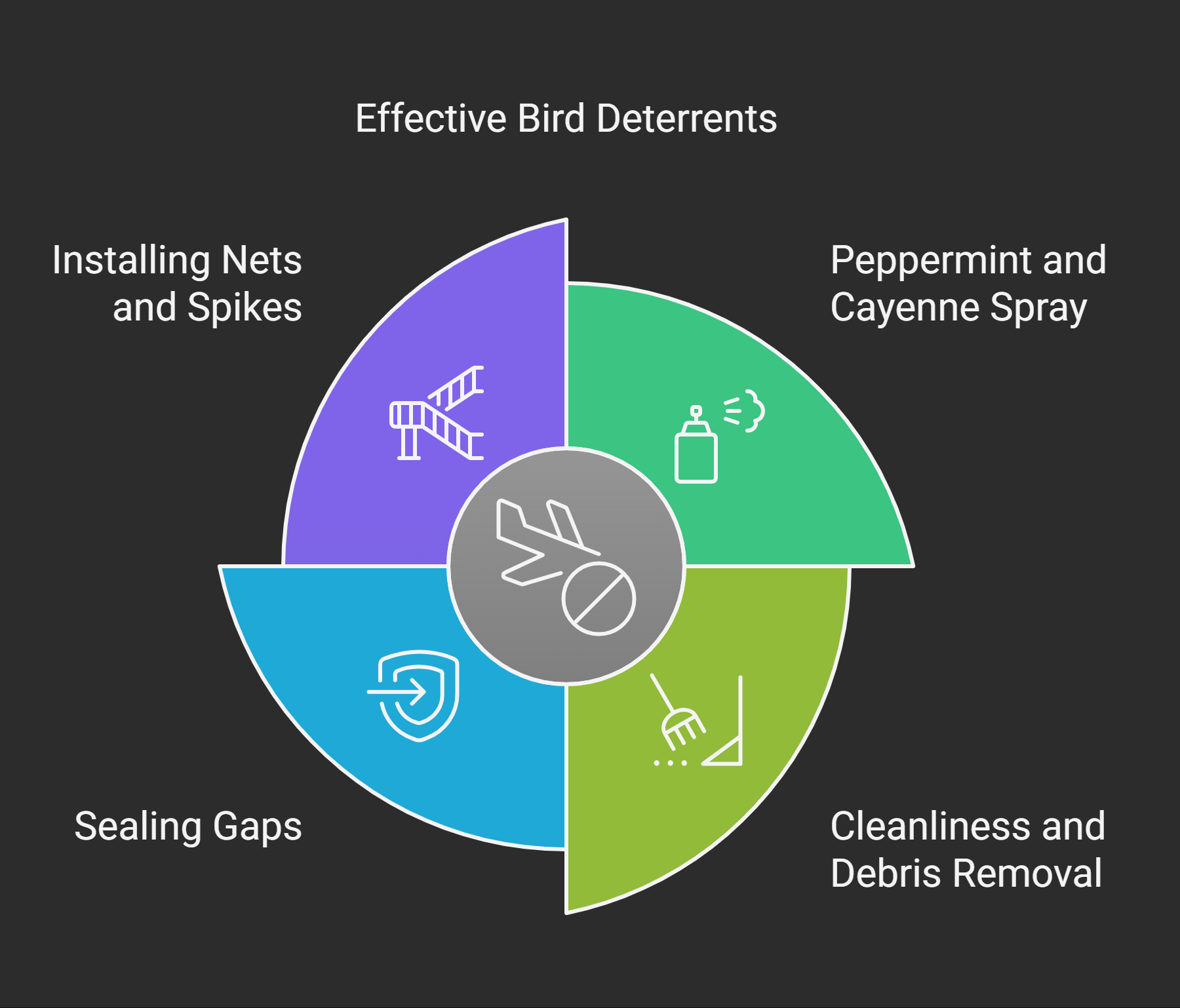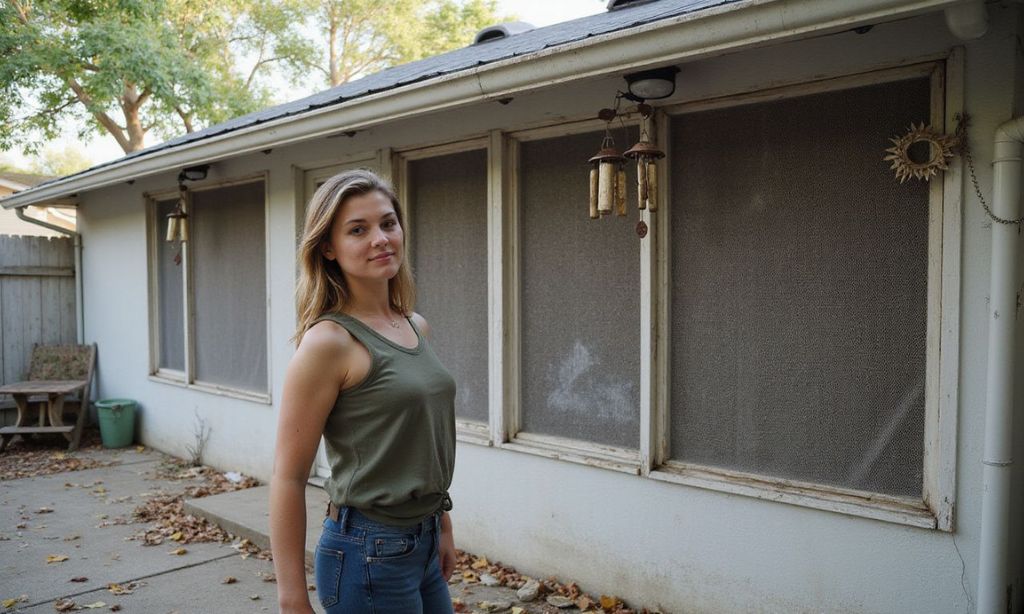Are birds building nests on your porch or in your rain gutters? They tuck twigs under porch lights and door wreaths. You face roof leaks, messy droppings, and loud cheeps at dawn. You just want a tidy yard, not a bird motel. Learn how to keep birds from building nests in this blog.
Key Takeaways
- Birds build nests on porches, rooflines, gutters, and light fixtures, causing clogs, pests, roof leaks, and fire risks.
- Install bird spikes or mesh netting (from Home Depot or similar) on ledges and gutters; add motion-activated lights or sprinkler alarms for extra deterrence.
- Use natural sprays of peppermint oil and cayenne pepper, hang reflective tape or shiny ribbons, and keep decks and eaves clear of twigs and debris.
- The Migratory Bird Treaty Act of 1918 protects active nests; disturbing them can incur fines up to $15,000 and requires US Fish and Wildlife Service approval.
- For safe removal from complex sites, hire a professional service like Bird B Gone, which uses humane nets, predator decoys, and pepper sprays to stop birds from nesting.
Common Nesting Sites for Birds
Birds might claim your eave or hitch a ride on a gutter, then set up shop under the roofline like it’s their own condo, thanks to those warm, quiet spots.
Next, learn how to keep these feathered tenants from moving in under your porch overhang or light fixture.
Porches and Decks
Front porches and wooden decks attract small songbirds looking for cozy spots. Songbirds tuck nesting materials under rail boards. Nests can block dryer vents or air ducts. A clogged vent cuts airflow and slashes system efficiency.
Nesting near siding can warp wood and stain paint.
Home Depot sells bird control spikes and mesh netting that fit under deck ledges. You can hang a predator decoy or shiny streamers to prevent birds from nesting. Such tricks also stop birds from building nests in deck crevices.
Peppermint extract spray and cayenne pepper mix repel roosts fast. Active motion lights scare birds away at night.
Rooflines and Gutters
I once spotted a wren squat in the rain trough like it owned the place. Sticks and leaves can jam those eaves fast. A clogged gutter can trap water, rot roof beams and cause roof leaks.
Acidity in bird droppings eats away at paint, wood and metal.
Attach avian spikes or a mesh screen along rooflines to keep birds away and stop them from nesting. Motion-activated lights or a sprinkler alarm can drive small birds off the eaves.
Spray on a bird repellent mist or perch a fake owl near vents. These nest prevention steps help you stop birds from building nests on your home and lower pest control fees.
Light Fixtures and Door Wreaths
Robins love to build nests atop porch lights and around wreaths. Nests in these spots pose fire risks near electric wires. They can ignite a flare if sparks fly. You can stop birds from nesting by lining fixtures with bird spikes or netting.
Wrapping wires in mesh makes them think twice about building nests on your house.
Sparrows can keep you up with dawn chirps. These feathery squatters pack twigs in door wreaths like backpackers. You can thwart them with reflective tape or small hooks in wreath loops.
Shiny strips flash in the sun, and they avoid that glare. This simple trick helps prevent birds from building nests in unwanted places.
How to Keep Birds from Building Nests: Effective Strategies
Wire barriers and mesh tools block prime nesting space on your porch. Motion-sensor lights and water sprayers startle roosting flocks into flight.
Install Bird Spikes or Netting
Bird spikes snap onto ledges, awnings, gutters, and rooflines. These tough metal or plastic strips block birds from perching. They keep birds from nesting in unwanted spots. Each strip spans one to two feet.
You mount them with screws or strong tape. Motion-activated lights and sprinklers boost the barrier. Lights and sprays startle any pigeon or starling.
Fine mesh netting covers gaps around decks, porches, and garage rafters. It wraps chimneys and vent openings to halt bird nest building. You choose durable nylon or stainless steel mesh.
Tuck the edges under shingles or trim for a neat finish. This tool stays up year-round as an invisible shield.
Use Motion-Activated Lights or Sprinklers
Motion-activated lights scare off roosting birds. A sensor spot by your porch glows bright as soon as a creature moves. It works like a burglar alarm for birds, so they avoid your roofline and gutters.
You can link the lights to sprinklers so a quick spray startles unwanted guests.
Install a water sprinkler with a motion detector to douse any nest-building birds on your deck. No one likes a surprise shower, not even a pigeon, so they often flee before they settle.
The sudden spray and flash of light send them flying to keep birds from making nests in unwanted places. This simple tool doubles as a bird deterrent to deter birds all year long.
Hang Reflective or Shiny Objects
Hang metallic ribbons or pinwheels near porches, rooflines, and light fixtures. Use reflective tape and shiny spinners to shine in prime nesting spots. Pair these with an ultrasonic repellent to add a sound barrier.
The shifting glint can spook migratory birds and keep them away from your home. A visual deterrent like this helps discourage birds from nesting on your property.
Natural Deterrents to Keep Birds Away
Jalapeño spray, spearmint oil, and a pristine deck act like bouncers at a club to keep sparrows from crashing your outdoor party—read on to find more tricks!
Use Peppermint or Cayenne Pepper Spray
Fill the spray bottle with one cup of water, ten drops of peppermint oil, and one teaspoon of cayenne pepper powder. Shake well. Mist around eaves, gutters, and deck rails. A strong scent deters birds from roosting.
Use repellent spray weekly.
Test spray on a small patch. Observe shifts in bird species quickly. Avoid surfaces that may stain. Reapply after any heavy rain. This trick keeps birds away from your home. Position spray near potential nesting sites on roofs and gutters.
It may repel small nuisance birds.
Keep the Area Clean and Free of Debris
Clear dried leaves, twigs, and yard waste with a blower. Use a rake or shears to trim thick shrubs near windows. This stops nesting in unwanted places around your home. It cuts bird activity before eggs appear.
Tidy porches, decks, and garage entryways by moving clutter into a covered trash bin. Seal gaps under gutters and light fixtures so birds can’t settle. You can install nets or spikes on rooflines.
This simple move prevents sparrows from using a nest box.
What to Do if You Find a Bird’s Nest
You find a nest, so grab your binoculars, check for eggs or chicks, honor laws like the Migratory Bird Treaty Act of 1918, and plan your next move—keep reading to learn more.
Identify if the Nest is Active or Abandoned
Inspect with opera glasses from six feet away. Spot fresh sticks, down feathers. Watch for parent sparrows feeding hatchlings at dawn. Hear soft chirps or faint fluttering inside light fixtures or rooflines.
Migratory songbirds pick gutters and eaves in nesting season.
Abandoned nests look brittle, dry and empty. No echoes sound inside if you tap gently using a wooden dowel. Motion sensor cameras can confirm no traffic. Law bars you from moving any nest with eggs or chicks.
The Migratory Bird Treaty Act of 1918 protects most species. Call wildlife control for safe removal.
Follow Local Wildlife Protection Laws
State rules forbid tampering with active nests for many birds. Officials at the US Fish and Wildlife Service issue fines up to $15,000 for violations. Call a wildlife officer before you remove roofline nests.
Birds often nest in gutters, eave corners, and light fixtures. Bird species are protected under federal and state codes. These laws drop legal risk and protect health, property, and bird migration patterns.
Install bird spikes or netting on ledges in winter. You can use motion-activated lights and sprinklers too. You get more ways to prevent birds. These tools stop birds from building a nest.
They scare birds, cut noise, and curb parasitism.
Identify the bird species before you touch any nest. Songbirds, woodpeckers, and some birds often attract protection year round. This act blocks nest moves from March 1 to September 1 in much of the US.
A professional bird control service like Bird B Gone can help deter birds. Its team uses humane nets, shiny disks, and pepper spray. You cut nest builds, avoid fines, and skip health risks to humans.
Clean the garage and deck before the next cycle. That stops crumbs, so birds may not build a nest.
Takeaways
Now you know how to keep birds from building nests. Stop nesting birds before they harm your porch or attic. Mesh barriers and needle strips keep flocks off ledges. Zesty mist wards off unwelcome guests near gutters. Smart beams plus sensor jets boost your deck defense.
Shiny ribbon with sound tubes startles feathered intruders. Bird pros tackle big problems fast and with care. You dodge structural damage and block health risks.








































